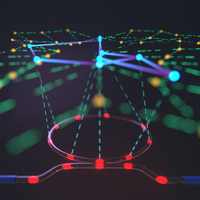Abstract
Gaussian boson sampling is a quantum computing concept based on drawing samples from a multimode nonclassical Gaussian state using photon-number resolving detectors. It was initially posed as a near-term approach to achieve quantum advantage, and several applications have been proposed since, including the calculation of graph features. For the first time, we use a time-bin encoded interferometer to implement Gaussian boson sampling experimentally and extract samples to enhance the search for dense subgraphs in a graph. Our results indicate an improvement over classical methods for subgraphs of sizes three and four in a graph containing ten nodes. In addition, we numerically explore the role of imperfections in the optical circuit and on the performance of the algorithm.
2 More- Received 21 June 2022
- Revised 26 August 2022
- Accepted 29 August 2022
DOI:https://doi.org/10.1103/PhysRevX.12.031045
Published by the American Physical Society under the terms of the Creative Commons Attribution 4.0 International license. Further distribution of this work must maintain attribution to the author(s) and the published article’s title, journal citation, and DOI.
Published by the American Physical Society
Physics Subject Headings (PhySH)
Popular Summary
Quantum computers promise to shift the paradigm for high-performance computing in the years to come. While large-scale, fault-tolerant machines capable of universal quantum computation are a distant goal, devices that can harness quantum-mechanical effects to solve a specific task faster than a classical computer are within reach. Here, we build an optical setup that implements an example of such a device—a Gaussian boson sampling (GBS) machine—dedicated to finding dense subgraphs of a graph, a task relevant to many questions in network science, graph compression, and biology. One could use it, for example, to find dense communities in social networks.
A GBS machine works by injecting nonclassical light into an optical circuit and measuring where the photons come out using single-photon detectors. By choosing the appropriate parameters for the input light and interferometer, GBS devices can be used to identify complex features of graphs or calculate the molecular vibronic spectra of molecules, among other applications. Even the largest supercomputers struggle to find solutions for such tasks.
In our work, we demonstrate a speedup in finding subgraphs when using the outputs from the GBS device compared with using random samples in a classical algorithm. Moreover, we use the temporal degree of freedom to encode the information in a novel way, opening a new door to solve scalability issues for future experiments.
We foresee the scaling up of similar approaches to apply GBS devices for practical problems. Our work provides a proof-of-principle example that the nonuniversal, but practical, approach to quantum computing is an avenue to solving dedicated problems with far fewer resources compared to a universal quantum computer.



